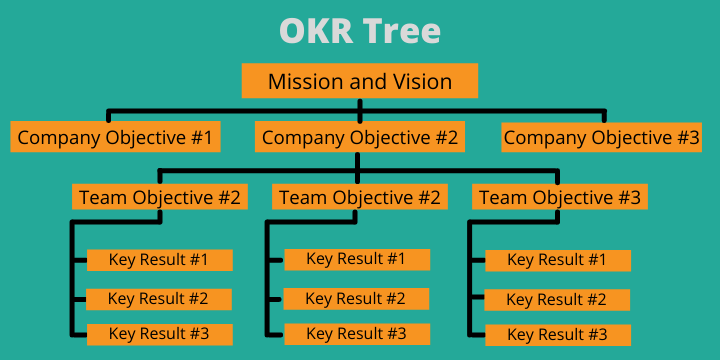OKRs Made Simple: Getting Started with Objectives and Key Results
OKRs (Objectives and Key Results) have helped companies like Intel and Google become industry leaders. Former Google CEO Larry Page says, “OKRs have helped lead us to 10x growth, many times over.” This guide will help you and your team create OKRs that elevate your performance and motivate your success.
While it takes skill and experience to become an OKR expert, anyone can begin to see results by simply starting with writing out and tracking their goals. A two-year study by Deloitte found that the biggest impact on employee engagement comes from “clearly defined goals that are written down and shared freely.”
Let’s start with some tips for effective Objectives and Key Results and then get started creating awesome OKRs!
How to Write Inspiring Objectives and Key Results
Objectives set your direction and focus for your planning period. Objectives should provide clarity on your desired outcome whether its driving growth, changing a process, or innovating on a new project. Objectives should not be tied to a number (Unlike Key Results).
Great objectives should be tied to your aspirational vision of where you want to be as an organization, as a team, and as an individual. According to Harvard Business Review, companies where their everyday activities are tied to the organization’s vision—are more than twice as likely to be top performers.
How many OKRs should you have?
While it may be tempting to pile on Objectives, their effectiveness comes from their focus. At the company level, there should only be one to two objectives for the planning period (most likely a quarter). This will cascade down into 1-2 Objectives for each team and 1-2 Objectives for each individual on these teams. Objectives should answer the question “What are the top one to two things we should strive to achieve this quarter to progress our long-term vision?”
At Google, OKRs fall into two categories: Committed Goals (like product releases, hiring, and customer impact) to be hit 100% and Aspirational Goals (like higher-risk, big picture growth and innovation) where 60-70% achievement is acceptable. If you are using OKRs to manage all your work, your company, team, and individuals should all have 1-2 of both committed and aspirational goals. If you’re just getting started with OKRs, we recommend focusing solely on aspirational goals to
Your objectives can also serve to balance each other. An Objective focused on improving efficiency can be balanced with one focused on quality. Don’t forget that by choosing what to focus on, you are also choosing what not to focus on.
How to Create Your Key Results
Key Results are the metric-bound targets you hit to achieve your Objectives. Defining a quantifiable measure of success in your Key Result provides clarity to your Objective and makes it easier to reach. Each objective should have around 3-5 Key Results attached to it.
Key Results can be thought of as the levers you pull to drive your objective. They should not be one-off tasks or deadlines. At the end of the quarter, your Key Results should allow you to say, as John Doerr explains, “without any arguments: Did I do that or did I not do it? Yes? No? Simple. No judgments in it”
How Aggressive should our Key Result targets be?
For Aspirational Objectives, you should set Key Results that are achievable at 60-70% confidence. As Google Veteran Rick Klau explains, “The “sweet spot” for an OKR grade is .6 — .7; if someone consistently gets 1.0, their OKRs aren’t ambitious enough. If you get 1s, you’re not crushing it, you’re sandbagging.”
This leads to greater creativity and experimentation when attempting to achieve your Objective. Your Key Results should stretch your team by setting a threshold just beyond what currently seems achievable. With a “growth mindset”, your Key Results help your team grow to accomplish Objectives.
OKRs in Practice
To understand how OKRs can transform an organization’s culture and improve performance it’s helpful to take a look at a few examples. OKRs are truly versatile and applicable in any context. As John Doerr explains, “They’re transparent vessels that describe the “what” and the “how.” The values we pour into those vessels are the answers for the question, “Why?”
Real-World Example 1- Gates Foundation and Guinea Worm
When Bill Gates started the Gates Foundation he began with Jim Collins guiding question from Good to Great: “What can you be the best at in the world?” Having built Microsoft, he settled on ‘using technology to create change’. From there, the foundation decided to focus on impacting DALY (Disability-Adjusted Life Years) through vaccination campaigns.
When John Doerr introduced OKRs to the Gates Foundation, they decided to set an objective of eliminating Guinea Worm worldwide. The objective (eliminating a particular disease) powered their mission (increasing length and quality of life). Their Key Results involved quarterly and annual targets for eradication program rollouts. As a result of their grants, global incidences of Guinea worm declined from 75,000 in 2000 to just 22 in 2015.
Example 2- Sustainability at Google
As part of a new sustainability initiative at Google, their team structured their sustainability goals into three objectives focused on reducing environmental impact: 1. “Design products and services for circularity and reuse materials at their highest environmental and social value.” 2. “Be the neighbor everyone wants in the communities in which we operate.” and 3. “Make technology that puts people first and expand access to the benefits of technology.” Each component contained a set of up to 3 key results focused on
By starting with an aspirational and open-ended objective like “Be the neighbor everyone wants in the communities in which we operate” Google inspires its employees to think creatively about how to enable their company mission with this objective. They break down their Key Results into ambitious but obtainable metrics like “100% of shipments of all Made by Google hardware to and from Google’s direct customers are carbon neutral.” and committing $150M to renewable energy projects to spur $1.5B in renewable energy. By publicly sharing this OKR, Google ensures they will be held accountable for living up to their stated values and goals.
Example 3- John Doerr and His Happy Family
OKRs can serve as powerful personal motivators as well. The godfather of OKRs, John Doerr, used his simple goal-setting framework to improve his relationship with his family. His mission was to be the best father and his objective was to spend quality time with his family. The key result he chose was “to get home for dinner by 6PM at least 20 nights a month, and be present, with our phones in another room”. At the 70% threshold, this meant at least 14 nights per month.
What does OKR success look like?
Success using OKRs comes down to 5 key factors (easily abbreviated to FACTS) outlined by John Doerr: Focus, Alignment, Commitment, Tracking, and Stretching. Let’s take a look at what each one means to your goal-setting.
Focus with OKRs
As previously mentioned, OKRs are just as much about choosing what to focus on as they are about choosing what not to focus on. When you select your 1-2 quarterly OKRs, you are selecting the work that matters most to achieving your mission. This selection should align with your stated values.
Alignment with OKRs
Successful OKR implementation requires aligning individual and team objectives with overall company objectives. The impact of OKRs is maximized when every member of your organization is working together to progress the mission. Transparently sharing these objectives and visualizing how they roll up to top line objectives unlocks the motivational power of aligned goals.
Commitment to OKRs
OKRs are public commitments to getting the work done that move your mission forward. This commitment requires accountability that starts with leadership. Rather than merely performance goals set by management, OKRs work best as promises agreed upon collectively. Any leader looking to begin implementing OKRs should start by publicly sharing and committing to their own set and clearly defining company mission, vision, and top-line objectives.
Tracking OKRs
Publicly sharing your goals and progress is a key driver of their success. By consistently tracking and reviewing goals, your organization will quickly understand where they are falling behind and strategize ways to improve performance. Transparent tracking increases accountability and ownership as well as improving on the teamwork needed to achieve ambitious goals.
Stretching Yourself with OKRs
The final component of OKRs is the stretch. By extending goals just beyond the current capacity of the organization, team, or individual OKRs encourage us to take a growth mindset. A great Objective should inspire aggressive but achievable Key Results that require innovation and creativity to achieve.
Track your OKR-Driven Success
Central to any OKR program is the ability to publicly share progress towards Objectives. Transparently tracking goals also allows for greater collaboration when identifying issues and correcting course. It also adds accountability to OKRs that motivate your team to keep them front and center in their daily routines.
At Google, each individual from CEO to the junior developer has publicly visible OKRs. Studies show however that only 51% of companies try to create aligned goals and a mere 6% actually revisit them. Deloitte found that companies who revisit goals quarterly see “threefold greater improvement in performance and retention than those that revisit goals yearly.” This is in line with internal Align data that showed 3.5X increases in performance with a system of publicly tracked goals.
The right system can make all the difference between OKR success and goals that soon become ignored. Any OKR system should transparently track company-wide, team-wide, and individual goals and demonstrate the alignment between them.
While some companies may attempt to track their OKRs in spreadsheets or existing systems, these methods often fail because they are not visible to every member of the organization. Additionally, the power of OKRs comes from the connection between quarterly objectives and long-term mission and vision. An effective OKR software helps every member of an organization understand that their day-to-day work matters to the organization’s long-term impact.
To learn more about the tools to connect OKRs with mission, vision, and values, try a sample version of Align’s OKR software today!






